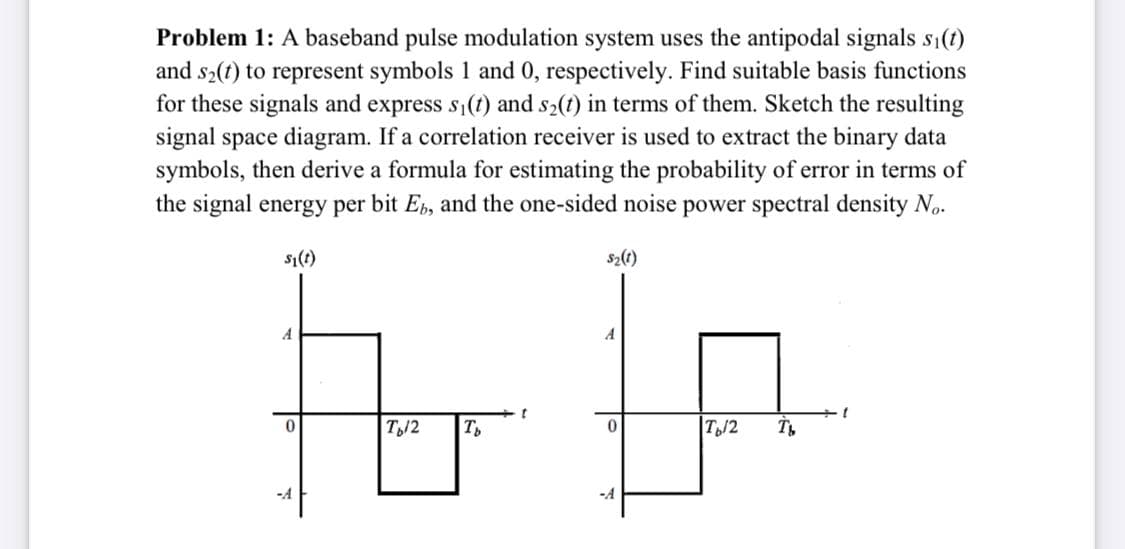Problem 1: A baseband pulse modulation system uses the antipodal signals s1(t) and s2(t) to represent symbols 1 and 0, respectively. Find suitable basis functions for these signals and express s1(t) and s2(t) in terms of them. Sketch the resulting signal space diagram. If a correlation receiver is used to extract the binary data symbols, then derive a formula for estimating the probability of error in terms of the signal energy per bit E, and the one-sided noise power spectral density N. s1(t) s2(1) A A T/2 T |T/2 -4 -A
Problem 1: A baseband pulse modulation system uses the antipodal signals s1(t) and s2(t) to represent symbols 1 and 0, respectively. Find suitable basis functions for these signals and express s1(t) and s2(t) in terms of them. Sketch the resulting signal space diagram. If a correlation receiver is used to extract the binary data symbols, then derive a formula for estimating the probability of error in terms of the signal energy per bit E, and the one-sided noise power spectral density N. s1(t) s2(1) A A T/2 T |T/2 -4 -A
Introductory Circuit Analysis (13th Edition)
13th Edition
ISBN:9780133923605
Author:Robert L. Boylestad
Publisher:Robert L. Boylestad
Chapter1: Introduction
Section: Chapter Questions
Problem 1P: Visit your local library (at school or home) and describe the extent to which it provides literature...
Related questions
Concept explainers
KVL and KCL
KVL stands for Kirchhoff voltage law. KVL states that the total voltage drops around the loop in any closed electric circuit is equal to the sum of total voltage drop in the same closed loop.
Sign Convention
Science and technology incorporate some ideas and techniques of their own to understand a system skilfully and easily. These techniques are called conventions. For example: Sign conventions of mirrors are used to understand the phenomenon of reflection and refraction in an easier way.
Question
None

Transcribed Image Text:Problem 1: A baseband pulse modulation system uses the antipodal signals s1(t)
and s2(t) to represent symbols 1 and 0, respectively. Find suitable basis functions
for these signals and express s1(t) and s2(t) in terms of them. Sketch the resulting
signal space diagram. If a correlation receiver is used to extract the binary data
symbols, then derive a formula for estimating the probability of error in terms of
the signal energy per bit E, and the one-sided noise power spectral density N..
S1(t)
s2(1)
A
T/2
T,
T/2
-4
-A
Expert Solution
This question has been solved!
Explore an expertly crafted, step-by-step solution for a thorough understanding of key concepts.
Step by step
Solved in 3 steps with 3 images

Knowledge Booster
Learn more about
Need a deep-dive on the concept behind this application? Look no further. Learn more about this topic, electrical-engineering and related others by exploring similar questions and additional content below.Recommended textbooks for you

Introductory Circuit Analysis (13th Edition)
Electrical Engineering
ISBN:
9780133923605
Author:
Robert L. Boylestad
Publisher:
PEARSON

Delmar's Standard Textbook Of Electricity
Electrical Engineering
ISBN:
9781337900348
Author:
Stephen L. Herman
Publisher:
Cengage Learning

Programmable Logic Controllers
Electrical Engineering
ISBN:
9780073373843
Author:
Frank D. Petruzella
Publisher:
McGraw-Hill Education

Introductory Circuit Analysis (13th Edition)
Electrical Engineering
ISBN:
9780133923605
Author:
Robert L. Boylestad
Publisher:
PEARSON

Delmar's Standard Textbook Of Electricity
Electrical Engineering
ISBN:
9781337900348
Author:
Stephen L. Herman
Publisher:
Cengage Learning

Programmable Logic Controllers
Electrical Engineering
ISBN:
9780073373843
Author:
Frank D. Petruzella
Publisher:
McGraw-Hill Education

Fundamentals of Electric Circuits
Electrical Engineering
ISBN:
9780078028229
Author:
Charles K Alexander, Matthew Sadiku
Publisher:
McGraw-Hill Education

Electric Circuits. (11th Edition)
Electrical Engineering
ISBN:
9780134746968
Author:
James W. Nilsson, Susan Riedel
Publisher:
PEARSON

Engineering Electromagnetics
Electrical Engineering
ISBN:
9780078028151
Author:
Hayt, William H. (william Hart), Jr, BUCK, John A.
Publisher:
Mcgraw-hill Education,